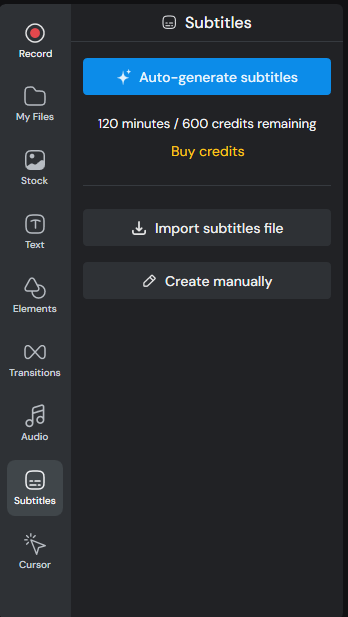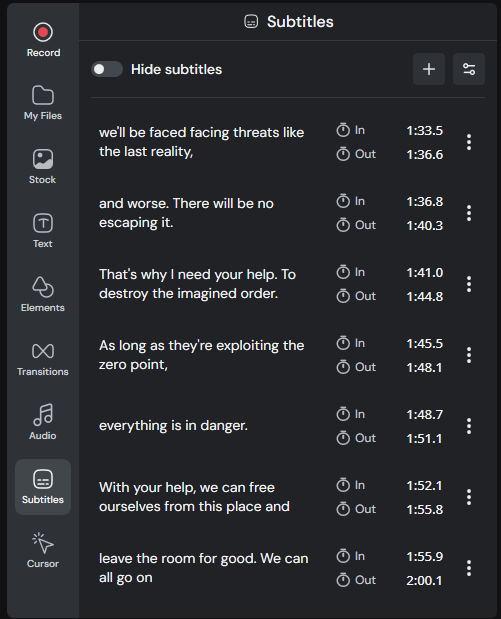Flashback Express 7
User Manual
Downloading and Installing
Recording a Video
Recorder Window
Recorder Settings
Selecting What To Record
Recording the Mouse Cursor
Starting and Stopping Recording
Recorder Control Bar
Advanced Recording Options
Annotating While Recording
Recording on a computer with dual GPUs
Previewing a Recording
Editing a Project
Editing Basics
Navigating the Project Editor
Working with Media
The Timeline
The Video Canvas
Styling Media
Editing Preferences
Exploring Media
Videos
Images
Animations
Shapes
Backgrounds
Text
Titles
Audio
Voiceovers
Subtitles
Blurs
Flashback Pro Movies
Applying Effects
Exporting
Licensing Flashback Express 7
Free vs Licensed Use
Purchasing a Flashback Express 7 License
Registering a Flashback Express 7 license
Upgrading From Pro 5 or Express 6
Managing Your Subscriptions
Feature Credits
Registering on an offline PC
Deploying a license to multiple PCs
License Troubleshooting
Misc.
How To Guides
Make a clip from a recording
Replace a voiceover
Record a facecam video
Schedule a recording session
Highlight the mouse cursor
Edit audio for an imported video
How To Move a Project to a New Computer
Record a clear voiceover
Flashback Express 7 Quick Start Guide
Flashback Express 7 FAQs
Flashback Express 6
User Manual
Downloading and Installing
Getting Setup to Record
The Recorder Window
Recording the Screen
Recording Windows and Regions
Recording Sound
Recording a Webcam
Recording the mouse cursor
Recording Settings
Recording
The Recorder Control Bar
Starting, Pausing and Stopping a Recording
Discarding or Restarting a Recording
Saving your recording
Scheduling a recording
Auto-trimming
Editing and Uploading
The Video Window
The Edit & Upload Window
Making a Clip
Uploading a Video
Exporting to other formats
Exporting Audio
Adding Subtitles
Licensing
Flashback Express Free vs Licenced
Purchasing a Flashback Express 6 license
Registering a Flashback Express 6 license
Registering Flashback Express 6 on an offline PC
Deploying a Flashback Express 6 license to multiple PCs
Flashback Express License 6 Troubleshooting
Feature Credits for Transcrptions
Misc.
How To Guides
How to record a facecam video
How to make a clip
How to schedule a recording session
How to capture the mouse cursor
Flashback Express 6 Quick Start Guide
Flashback Express 6 FAQs
Camigo
User Manual
Getting Started
Camigo System Requirements
Downloading and installing
Setting up Camigo
Checking for Updates
Camigo Settings
Using Camigo
Customizing your video
Licensing
Support
Camigo Quick Start Guide
Camigo FAQs
Video Converter
User Manual
Getting Setup
Video Converter System Requirements
Downloading and installing Video Converter
Preferences
Free Trial
Using Video Converter
Converting Format
Format settings
Turbo Conversion
Creating Clips
Cropping a video
Applying Effects
Adding Watermarks
Changing Speed
Inserting Subtitles
Licensing Video Converter
Video Converter Quick Start Guide
Video Converter FAQs
Table of Contents
Subtitles
Updated
by Gareth Casey
If your video project contains speech, you can add subtitles so that viewers can read what is said instead of listening to it.
You have the choice of allowing Flashback Express 7 to generate the subtitles for you, manually creating them yourself or importing them from a subtitles files if you already have one.
Any subtitles that you add will be included when you export your video.
Adding Subtltles
Auto-Generating Subtitles
To create your subtitles, go to the Subtitles tab of the Media Panel and then click the Auto-generate subtitles button. Then select which video or audio clip to transcribe the subtitles from and the language of the speech in that selected clip and click Generate to begin.

If there are multiple video or audio clips in your video project and you want the speech from all of them to be subtitles, you will need to auto-generate the subtitles for one clip at a time until they have all be done.
The generated subtitles will be broken into the blocks that will be displayed on your video project along with the timestamps of when each block will appear in the video. Clicking a block will jump you to that time in the video so you can see how that block appears on top of your video.

If any of the auto-generated subtitles need correcting, simply click the relevant block of text in the transcript and make the requried changes to the text.
Manually Entering Subtitles
To manually create your subtitles, go to the Subtitles tab of the Media Panel and then click the Create manually button.
3 placeholder subtitle blocks will be added to get you started. Simply replace the placeholder 'New subtitle text' text in each of those with the text that you want to be displayed.
Extra blocks can be added by clicking the  button to add a new block following the currently selected block or by clicking the Add Subtitle button to add a block at the end.
button to add a new block following the currently selected block or by clicking the Add Subtitle button to add a block at the end.
When the text has been entered for a block, use the In and Out times to set when that block will appear and disappear. The timings of blocks cannot overlap so you will not be able to set an In time that is before the Out time of the previous block or an Out time that is later than the In time for the following block.
You can toggle whether the timings are diaplayed by clicking  button and clicking the Show timings or Hide timings option.
button and clicking the Show timings or Hide timings option.
Importing Subtitles
If you have used another application to generate subtitles for one of the video or audio clips that you want to add subtitles for, you can import the SRT file containing those subtitles by going to the Subtitles tab of the Media Panel and then clicking the Import subtitles file button. Then select which video or audio clip the subtitles should be matched to and click Import SRT file to select your subtitles file.
Alternatively, if you have already added some subtitles for one clip in your project and then need to import subtitles for another video or audio clip, you can import those subtitles by clicking the  button on the Subtitles tab and then selecting Import Subtitles File in the menu that appears.
button on the Subtitles tab and then selecting Import Subtitles File in the menu that appears.
Customizing Subtitles Style
When the Subtitles tab in the Media Panel is selected, the subtitle's style properties will appear in the Style Panel allowing you to custom the following:
Text Font and Size - By default, Arial at size 35 is used for subtitles but you can change both the font and the size.
Text Color - By default, subtitle text will be white but you can also pick from a selection of preset colors or create your own color.
Position - By default, subtitles will be added in the Center bottom postion, which is the standard location for subtitles to be displayed. However, you can adjust the display location to be left, center or right and top, center or bottom.
Background - By default, the background option is enabled and adds a semi-opaque colored background behind the subtitle text.
Box color - By default, a black blackground is used but you can pick from a selection of preset colors or create your own color. (Only displayed when Background is enabled)
Padding - Allows you to adjust the amount of space between the subtitle text and the edge of the background box. Adding more padding will increase the size of the background box. (Only displayed when Background is enabled)
Corners - Allows you to adjust how rounded the corners of the background box are. Increasing the value will make the corners appear more rounded. (Only displayed when Background is enabled)
Downloading Subtitles
You can export a copy of the generated subtitles by clicking the  button and clicking the Download (.srt file) option in the menu that appears. The SRT file that is saved is a standard format for subtitles so will be be compatible with other applications that support subtitles.
button and clicking the Download (.srt file) option in the menu that appears. The SRT file that is saved is a standard format for subtitles so will be be compatible with other applications that support subtitles.
